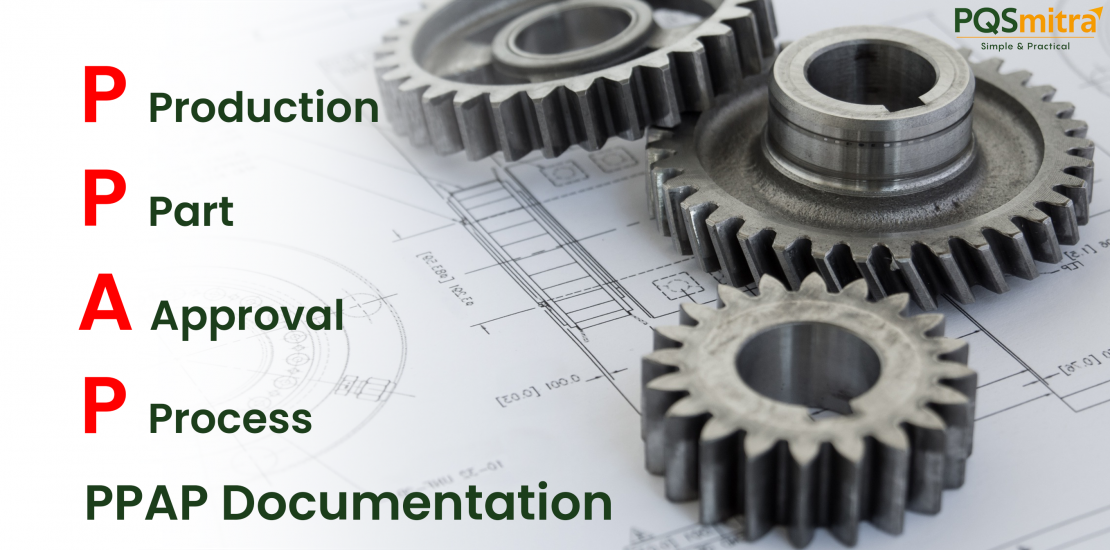- December 12, 2024
- Posted by: PQS_Mitra_Main_Access
- Categories:

Introduction
If you’re in the automotive or manufacturing supply chain, you’ve likely heard the term PPAP tossed around in vendor meetings, quality audits, or customer approvals. But what does it really mean? And more importantly, why is it critical for suppliers to understand it thoroughly?
The Production Part Approval Process (PPAP) is a standardized approach used primarily in the automotive industry to ensure that suppliers can meet customer requirements consistently during actual production. Simply put, it confirms: “Can you make what you say you can make, with the same quality, every time?”
Developed by the AIAG (Automotive Industry Action Group), PPAP is now widely adopted across manufacturing sectors, especially where consistency, traceability, and quality assurance are crucial.
Why PPAP Isn’t Just Paperwork
Many new suppliers often perceive PPAP as just another layer of documentation, but it’s far more strategic. It serves as a quality assurance checkpoint—before the product reaches mass production. By implementing PPAP, companies avoid costly quality issues, minimize customer complaints, and build credibility.
The PPAP process helps:
- Prove that design specifications are correctly understood.
- Validate that processes consistently deliver quality.
- Demonstrate readiness for serial production.
- Identify and control risks early.
That’s why customers, especially OEMs and Tier 1 manufacturers, often require PPAP as a non-negotiable step before full production begins.
The Core Elements of a PPAP Package
A PPAP submission typically includes 18 key documents (as per AIAG 4th edition), although the level of submission varies depending on customer requirements. Some of the most critical documents include:
- Design Records
- Engineering Change Documents
- Process Flow Diagrams
- FMEA (Failure Modes and Effects Analysis)
- Control Plans
- Measurement System Analysis (MSA)
- Initial Sample Inspection Reports (ISIR)
- Appearance Approval Reports (if applicable)
- Production Trial Run Results
These documents not only demonstrate capability but also provide traceability and root cause analysis paths in case of future issues.
For organizations to compile these documents accurately and effectively, they need deep coordination across design, production, quality, and supplier teams.
Why PPAP Knowledge Is a Must for Suppliers
For suppliers, PPAP is not just a formality—it’s a license to operate in high-standard environments. It sets the stage for:
- Customer Trust: Clients are more confident in suppliers that consistently pass PPAP.
- Process Control: It ensures internal process mapping and control mechanisms are robust.
- Audit Readiness: PPAP documentation is often reviewed during internal or third-party audits.
- Problem Prevention: Early-stage controls reduce late-stage failures.
And here’s the thing: the accuracy and reliability of a PPAP submission depend heavily on how well the team understands each element—not just in theory, but in practical application. This is where structured training becomes essential.
How Training Builds Supplier Capability
When organizations face PPAP challenges, it’s often due to fragmented understanding across departments or a lack of standardization in documentation and quality systems.
To streamline this, many organizations turn to PPAP-specific training programs that bring all stakeholders onto the same page. These programs are designed to:
- Explain the purpose and structure of each of the 18 PPAP elements.
- Show how to complete documentation effectively.
- Clarify customer submission level requirements (Level 1 to Level 5).
- Build an understanding of linkages between FMEA, Control Plans, and MSA.
- Train teams on identifying common gaps and avoiding rejections.
Whether the team is new to PPAP or needs a refresher before a critical customer submission, training provides the necessary clarity, confidence, and consistency.
Understanding When and Where Training Fits In
Training is most effective when it’s provided at two key moments:
- Before New Product Development
It ensures that project and quality teams are aligned with customer expectations early on. - Before or After an Audit
Whether to prepare for audits or to close non-conformities, training serves as a corrective and preventive strategy.
Organizations may opt for online or onsite sessions, depending on the nature of their operations and team availability. These sessions can be customized for different departments—design, quality, production, and documentation teams.
The impact? A smoother PPAP submission process, reduced back-and-forth with customers, and stronger internal quality systems.
Conclusion
The Production Part Approval Process may look like a stack of paperwork on the surface, but it represents something much deeper—a company’s commitment to quality, consistency, and customer satisfaction.
When suppliers understand PPAP well, they build better products, maintain stronger customer relationships, and position themselves as reliable partners in the supply chain. But this understanding doesn’t happen automatically—it must be taught, reinforced, and practiced.
That’s why structured training in PPAP is no longer optional—it’s essential for suppliers who want to play a lasting role in high-performance industries.
PQSmitra offers practical and industry-relevant PPAP training programs—both online and onsite—with certification. Whether you’re a new supplier or want to upskill your team, our training equips you with the knowledge and tools to handle PPAP with confidence and competence.
Leave a Reply Cancel reply
Kindly submit a business inquiry online and we will get back to you!
OR
Call us on 022-2893 8687 | +91-9820204373
